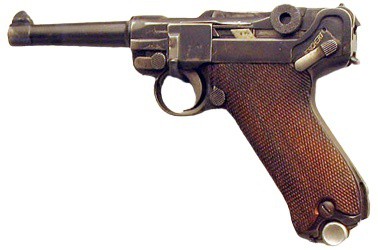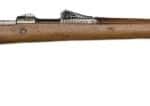
Introduction to the Luger Pistol
The Luger Pistol, officially known as the Pistole Parabellum 1908 or simply as the Parabellum, is a toggle-locked recoil-operated semi-automatic pistol that was designed by Georg Luger in 1898 and produced by German arms manufacturer Deutsche Waffen- und Munitionsfabriken (DWM) beginning in 1900. Here's an overview of its history, development, design, and use throughout various periods.
Origin and Early Development
The Luger Pistol's design was an evolution of Hugo Borchardt's C-93 semi-automatic pistol. Georg Luger was tasked with improving the Borchardt design, resulting in the creation of the Luger Pistol. Its improved ergonomic design and mechanics were seen as a significant advancement over Borchardt's original concept.
Design
The distinctive appearance of the Luger Pistol, featuring a jointed arm in lieu of a slide, is one of the most recognizable features of any pistol design. Its toggle-lock mechanism utilizes a jointed arm to lock the weapon in place, which then recoils and opens to facilitate the loading of the next round.
The standard caliber of the Luger Pistol was 9x19mm Parabellum, a cartridge that was later to become the most popular and widely-used pistol cartridge in the world. The Luger's design also allowed for chambering in various other calibers, such as .30 Luger.
Adoption by Military Forces
The Luger Pistol was adopted by the Swiss Army in 1900, making Switzerland the first country to adopt it. The German Navy adopted the pistol in 1904, followed by the German Army in 1908, giving rise to the Pistole 08 name.
During World War I, the Luger Pistol was the standard-issue sidearm for the German military, solidifying its reputation for reliability and precision. The pistol remained in service with the German military through World War II.
Variants and Modifications
Throughout its production, various modifications and variations of the Luger Pistol were created. Some of the most notable include:
- LP08 or "Artillery Luger": A variant with a longer barrel and adjustable sights, designed for artillery crews.
- Naval Luger: This model featured a 150mm barrel and was specifically adopted by the German Navy.
- Commercial Models: Various commercial models were produced and made available to civilian markets.
Usage in Other Countries
Aside from Germany and Switzerland, the Luger Pistol was adopted by several other nations. It was used by the Royal Bulgarian Army, the Finnish military, and was even tested and thoroughly evaluated for use by the United States, but it was not adopted for standard issue.
Legacy and Impact
The Luger Pistol’s unique design, accuracy, and history of service in two world wars have made it an iconic firearm. Collectors and firearms enthusiasts alike value it for its historical significance and aesthetic appeal.
While it has been largely replaced in modern military service by more recent designs, the Luger's influence can still be seen in various aspects of firearms design and development.
Conclusion
The Luger Pistol represents a significant chapter in the history of firearms development. Its innovative toggle-lock design, wide military adoption, and distinct appearance have earned it a place as one of the most recognizable and storied handguns in history.
Though the Luger is no longer a front-line military pistol, its historical importance and impact on firearms design continue to be acknowledged. Its association with pivotal moments in military history, its engineering innovations, and its aesthetic appeal ensure that the Luger Pistol remains a symbol of a bygone era and continues to capture the imagination of firearms enthusiasts around the world.
To participate in forums about the Luger Pistol, click here.
Read more about Lugers:




If you know of any forums or sites that should be referenced on this listing, please let us know here.


